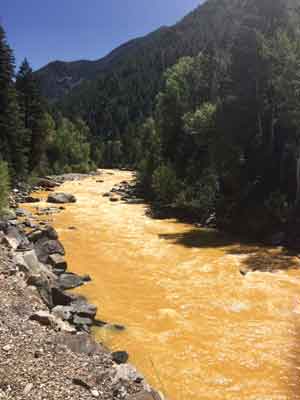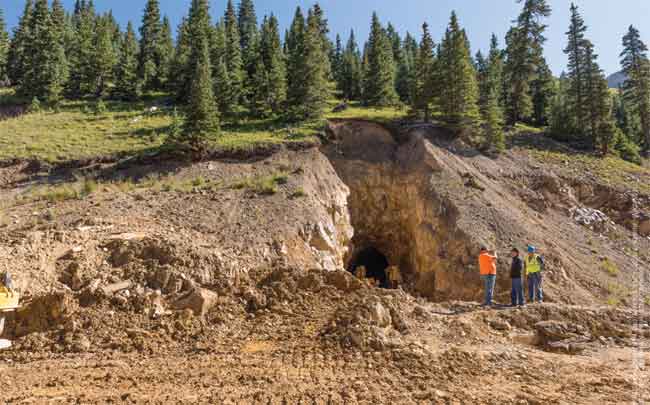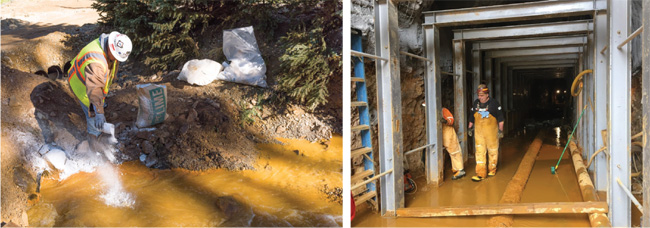November/December 2016
Making It a Federal Case
BY DANIELLE BOYKIN

ON AUGUST 5, 2015, AN ENVIRONMENTAL PROTECTION AGENCY TEAM CONDUCTING A CLEANUP PROJECT AT THE ABANDONED GOLD KING MINE IN COLORADO ACCIDENTLY CAUSED A SPILL OF MORE THAN THREE MILLION GALLONS OF UNTREATED WASTEWATER AND TOXINS INTO THE ANIMAS RIVER.
Over the past few years, catastrophic events like the Deepwater Horizon tragedy and most recently the Gold King Mine disaster have only reinforced the reasons why licensed professional engineers are necessary to protect the public health, safety, and welfare.
NSPE has long been at the forefront of advocating for expanding the role of the professional engineer on federal projects. According to NSPE Position Statement 09-1767, the Society advocates that federal employees, who by federal statute may be exempt from state engineering licensure laws, but who are in responsible charge of engineering activities as defined in the National Council of Examiners for Engineering and Surveying’s Model Law, should be required by federal agency policy to be licensed professional engineers in at least one jurisdiction.
In the past year, the Society has made substantial progress in this effort to increase public protections.
Changing the Environment
On August 5, 2015, an Environmental Protection Agency team conducting a cleanup project at the abandoned Gold King Mine in Colorado accidently caused a spill of more than three million gallons of untreated wastewater and toxins into the Animas River. The Gold King Mine disaster serves as yet another reminder of how professional engineers should be in responsible charge of projects that can have dire consequences for the public.
NSPE has played a leading role in the disaster’s aftermath to ensure that there are more safeguards in place to reduce incidents of this nature. Immediately following news of the spill, NSPE urged the EPA and all federal agencies to review their existing requirements and practices pertaining to the practice of engineering.
The Society has found a strong professional engineering ally in Rep. Bruce Westerman, P.E., (R-AR). Westerman, an NSPE member, believes that a spill at the Gold King Mine site could have been significantly mitigated if the EPA had followed the state’s engineering practice laws established to safeguard life, health, and property, and to promote the public welfare.
NSPE has worked with Westerman to make changes within the EPA and the Department of the Interior that reflect the value of professional engineering expertise. “He is able to speak to the issue, directly, as a licensed PE and that license provides him a perspective that is unique to nearly all other federal legislators,” says NSPE President Kodi Verhalen, P.E., Esq., F. NSPE. She also points out that Westerman is not the only PE in Congress. He is joined by Rep. David McKinley, P.E., of West Virginia, who is also an NSPE member.
During a Congressional committee hearing on the Gold King Mine, Westerman asked EPA Administrator Gina McCarthy why a licensed professional engineer was not in responsible charge of the site cleanup project. McCarthy declined to provide an answer, but she did express surprise at learning how few licensed design professionals work for the agency in that particular region.
In September 2015, Westerman filed a complaint with the Colorado state licensing board. The complaint alleged that the EPA team was involved in the practice of engineering and violated the state’s practice act, which says that “an entity may practice or offer to practice engineering in Colorado only if the individual in responsible charge of the entity’s engineering activities performed in Colorado is a professional engineer licensed in Colorado.”
Soon after Westerman’s complaint was filed, a federal report released on October 22, 2015, provided indisputable evidence that proper engineering expertise is needed to protect the public. The report recommended the following “prudent engineering considerations” that the EPA should follow: (1) incorporate a potential failure modes analysis into project planning; (2) conduct a downstream-consequences analysis and consider the effects of an accidental release as well as prevention measures; (3) directly measure the water conditions in a blocked mine prior to opening it; and (4) obtain independent expertise to review project plans and designs prior to implementation when significant consequences of failure are possible.
Where do the legal issues stand in the aftermath of the Gold King Mine incident? An investigation by the EPA’s Office of Inspector General has been under way for the past year. In June, New Mexico announced that it was pursuing a lawsuit against Colorado for the spill; that was followed by a lawsuit against the EPA filed by the Navajo Nation. On October 6, the Department of Justice announced that it will not prosecute an EPA employee involved in the spill. The EPA will now determine if any administrative actions will be taken against the employee.
The advocacy and legislative roles of Westerman and McKinley, says Verhalen, show why it’s increasingly important to have professional engineers serving as elected and public officials. “Those with responsibility for the creation of legislation and regulation, whether at the federal, state, or local levels, should be comprised of individuals with varying backgrounds and experiences—principles our country was founded upon,” she says. “Having these voices present with expertise on engineering issues when the public health, safety, and welfare is at issue is incredibly important.”

MEMBERS OF AN EPA RESPONSE TEAM STAND OUTSIDE OF THE GOLD KING MINE ENTRANCE ON AUGUST 14, 2015. CREDIT: SEPA ENVIRONMENTAL PROTECTION AGENCY (GOLD KING MINE - AUGUST 14, 2015) [PUBLIC DOMAIN], VIA WIKIMEDIA COMMONS
A PE Model
NSPE’s sustained advocacy for increasing the role of the professional engineer at the federal level is starting to pay off as agencies are beginning to acknowledge the value of engineering licensure. In June, the EPA issued a final rule on emission standards in the oil and natural gas sectors that recognized the need for licensed professional engineers to be in responsible charge of engineering projects, both in an independent third-party capacity as well as in an in-house role.
The EPA further acknowledged in its final rule that PEs, whether independent or employees of a facility, will uphold the integrity of their profession and only certify documents that meet the prescribed regulatory requirements. The agency concluded that a professional engineer is able to give a fair technical review because of the oversight programs established by the state licensing boards that will subject the professional engineer to penalties, including the loss of license and potential fines, if certifications are provided when the facts do not warrant it. In addition, the personal liability of the professional engineer provides strong support for the requirement that certifications must be performed by licensed professional engineers.
The Society will continue to advocate that the EPA go even further by ensuring that professional engineers are in responsible charge of all agency engineering projects. “The EPA’s recognition of the PE as critical in environmental engineering as it relates to regulation and compliance, and the PE’s foremost responsibility to protect the public health, safety, and welfare, has certainly been a positive step for the agency,” says Verhalen. “NSPE continues to advocate for the incorporation of PEs in additional federal issues that may have an impact on the public.”
Staying Steadfast
Change doesn’t always come quickly, yet NSPE leadership is committed to advancing licensure to protect and save lives. In 2010, an explosion aboard the Deepwater Horizon oil rig resulted in 11 fatalities and the discharge of more than three million barrels of oil into the Gulf of Mexico. This disaster led to a public health crisis and dire economic consequences for Gulf states. It highlighted once again the need to have a licensed professional engineer involved in inspections where public safety is in jeopardy. Acknowledging that offshore oil-drilling is inherently risky, the Society recommended that same year that PEs should have direct supervision over all engineering design, operations, and maintenance of offshore oil rigs.
In April—six years after the oil rig explosion—the Department of the Interior’s Bureau of Safety and Environmental Enforcement finalized comprehensive safety regulations in response to the disaster. A rule in the regulations requires a licensed professional engineer in cementing and casing situations to examine, review, approve, and certify changes or remedial measures as part of the “Oil and Gas and Sulfur Operations in the Outer Continental Shelf Blowout Preventer Systems and Well Control” regulations.
While NSPE has remained steadfast in advocating the importance of the PE as it relates to safety regulations for deepwater drilling, Verhalen acknowledges that it has helped that the Society wasn’t a lone voice. Many NSPE state societies and other organizations also recognized the importance of the PE in ensuring public protection. “Additionally, it is important to note that this particular effort covered six years,” she says. “We must continue the work we are doing and remain patient but committed to our fundamental principles: that PEs are committed to holding the public health, safety, and welfare above all other considerations in their quest for the advancement of engineering and our society.”
Verhalen believes that it’s also important that members are vocal in their support of NSPE and its efforts. “Our members must be willing to educate legislators and public officials about why the involvement of PEs is important in matters that affect the public health, safety, and welfare,” she says.
Read more about NSPE’s recent federal regulatory advocacy in NSPE Today’s Policy Perspectives column.
2016 PE Advocacy Highlights
Gas Collection and Control Systems
On September 1, the EPA included strong requirements for a PE in its final rule on emissions and compliance related to municipal solid waste landfills. NSPE commended the agency for proposing new safety measures requiring a professional engineer to prepare site-specific gas collection and control system plans as part of the proposed rule. In the final rule, the EPA requires that design plans continue to be prepared and approved by a PE. The rule mandates that “the state plan must include a process for state review and approval of the site-specific design plan for each gas collection and control system. The collection and control system design plan must be prepared and approved by a professional engineer.”
Qualifications for Mining Registrants
The Society submitted a public comment to the Securities and Exchange Commission on August 16 in response to its proposed rule Modernization of Property Disclosures for Mining Registrants. The proposal requires mining companies to disclose resources and reserves to investors and also requires a “qualified person” to classify a deposit as a reserve. In order to ensure the public health, safety, and welfare, NSPE is urging the SEC to revise the rule to define a “qualified person” as a licensee in good standing with a board authorized by US state statute to regulate professionals in the mining, geoscience, engineering, geology, and/or related field.
Abandoned Mine Lands Cleanup
To address the issues surrounding proper cleanup of abandoned mine lands, NSPE pushed for a provision requiring PEs to prepare and seal engineering reports as part of all permit applications for abandoned mine lands cleanups. The Locatable Minerals Claim Location and Maintenance Fees Act of 2015 (H.R. 3843) targets Good Samaritan remediation of abandoned mine lands and sets up a system for resolving this long-term public health, safety, and welfare issue. The original bill was introduced last year, but it didn’t require a PE. The Society worked to get the House Natural Resources Committee to pass a revised bill in August to include a PE requirement.
Learn more about NSPE’s advocacy work on the Action on Issues page.

LEFT PHOTO: AS WATER EXITS THE MINE, IT FLOWS INTO A SYSTEM OF FOUR TREATMENT PONDS. THEY PROVIDE RETENTION TIME TO ALLOW THE PH TO ADJUST. LIME IS ADDED TO A SETTLING POND TO ASSIST IN THE PH ADJUSTMENT OF THE WATER PRIOR TO DISCHARGE TO CEMENT CREEK ON AUG 14, 2015. RIGHT PHOTO: EPA RESPONSE TEAM WORKING INSIDE THE GOLD KING MINE
PHOTOGRAPHS FROM LEFT: USEPA ENVIRONMENTAL PROTECTION AGENCY (PRESENTATIONS JULY 26 AND 28, 2016) [PUBLIC DOMAIN], VIA WIKIMEDIA COMMONS; BY USEPA ENVIRONMENTAL PROTECTION AGENCY (GOLD KING MINE - AUGUST 14, 2015) [PUBLIC DOMAIN], VIA WIKIMEDIA COMMONS


